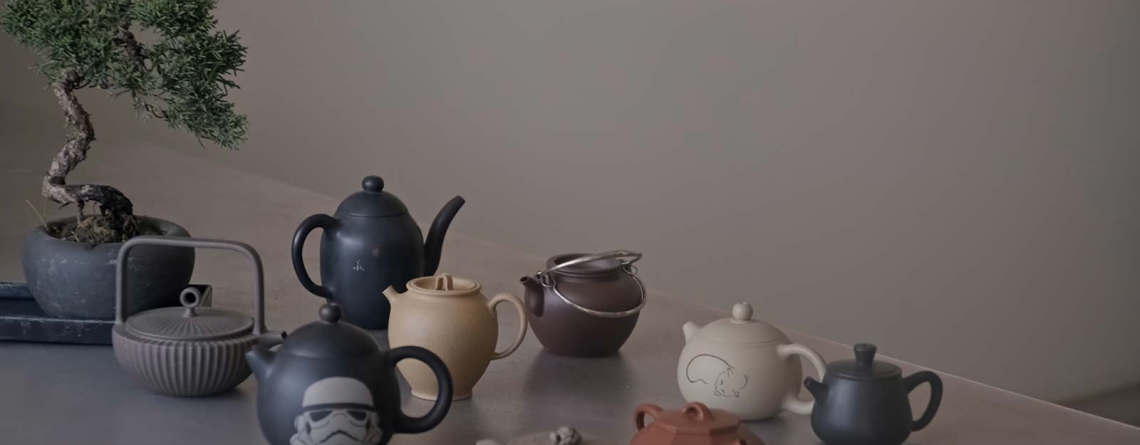Yixing vs Jianshui Teapots & Teaware: Differences & Similarities
When getting into gongfu brewing, Chinese tea, teapots and the like, there are 2 clays you’re most likely to hear about. Yixing zisha and Jianshui zitao. We won’t get into which clay is better or worse for your tea, as that’s a long, subjective discussion for another time. We will, however, go over some of the primary differences between the two.
Geography, Composition:
To start, the sources for these clays are quite far apart. The town of Yixing, where zisha comes, is located close to the East coast of China, on the edge of Tiahu lake. Meanwhile, Jianshui, the home of zitao, is a small town located in the southwest province of Yunnan, not far from the border with Vietnam. With thousands of km between these 2 sources, there are bound to be differences in mineral composition as well.
Exact mineral compositions can be a bit difficult to compare, as Yixing zisha has many sub-categories that have their own variation
But both clays are high in iron and produce a wide range of colours.
Yixing Zisha can include red zhuni, purple zini, white, yellow or brown duanni, orange jiangponi and many other subcategories.
Similarly, zitao ore has five common colours, which when mixed into a clay generally fall into white clay and red clay. The final colour of teapot made from red clay can vary depending on the oxidization level, ranging from red to black.
Another major compositional difference between them is the grain density, with zisha having a lower grain density than the more refined zitao. This aspect also affects the durability and structural strength of the final product.
Construction Methods
This difference in grain density leads to the next point: how they’re made.
The traditional handmade methods for these types of clay are quite different. Jianshui zitao is almost always hand thrown and wheeled. Yixing zisha, on the other hand, is typically slab-built. This means flat pieces of zisha are hand-formed into the shape of a teapot, either entirely by hand or with the assistance of a mold to make the process more consistent and a bit easier.
There can be exceptions to this, but these are the traditional and typical methods.
Since Jianshui clay has to be wheeled, it’s unusual to find any square shaped pots or sharp angles on them.
Yixing teapots, however, can be formed into round, square, or just about any other shape imaginable.
Firing Temperatures
Both clays are fired at high temperatures, however, the range can differ. As we already mentioned, Yixing zisha has quite a few subcategories of clays. These clays come from different areas or layers in the mine and due to their own compositions can require different firing temperatures, which range from 1000 – 1200 celsius. The firing temperature affects not only the final colour of the teapot, but the porosity as well.
Jianshui zitao, however, has a much tighter firing range, at 1120-1180 Celsius.
Price Differences & Scarcity
Pricewise, teapots made from either of these clay can be affordable or luxuriously expensive, based on a number of factors.
When it comes to Jianshui zitao, the price range is a little bit tighter. Jianshui teapots don’t reach as low a price as some mass produced “Yixing” teapots due to the difficulty in developing an industrialized methods of processing of clay. This is also a positive as it means buying a Jianshui teapot means getting Jianshui clay.
On the high end, both clays can fetch a pretty penny depending on the artistry and workmanship. The more developed industry in Yixing takes it to another level though, with some potters being recognized as nationally famous artists and pushing their work into the 10s of thousands of USD.
Clay scarcity is another factor that comes into play. While resources for Jianshui clay are far from being exhausted, most of the original mines for Yixing clay have been closed or heavily restricted. Fortunately many Yixing potters still hold a sizeable cache of these sought after clays, but the limited availability still makes them more precious.
This is merely a brief summary of some of the differences and similarities, certainly non-exhaustive. All of these differences can be explored much deeper, which we hope to do in the near future.



Leave a Reply
You must be logged in to post a comment.